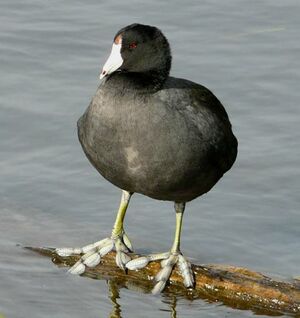Fulica Americana

American coot - Fulica americana
Habitat
Fulica americana lives in freshwater lakes, ponds, or marshes. They are also sometimes found in brackish water, as well as manmade ponds in parks or on golf courses.
Range
The American coot is a migratory bird. During the summer, they are found in the northern United States and southern Canada, and during the winter, they are found in the southern United States from California to Florida. While typically found in the contiguous United States, they have also been found in Alaska and South America.
Description
The American coot is about 38 cm long with a wingspan of 58 to 71 cm. They have dark grey feathers with a white patch under the tail. Their bill is white with a red portion on the upper edge and they have lobed toes, which make them excellent swimmers. Additionally, coots have short, rounded wings which causes them difficulty when taking off.
Ecological Notes
Fulica americana has an average lifespan of 9 years. Coots are the only member of the rail family to live in groups and they migrate in flocks as well. They make a variety of noises, such as grunting or clucking, in order to communicate between each other and to threaten predators, the main of which is the osprey. Another form of communication is splashing, which is used to attract mates or discourage predators. The American coot is an omnivorous species with the ability to dive for its food. They feed on small aquatic animals, insects, and vegetation.
Personal Information
I spotted several American coots with several classmates while birding on Pea Island, North Carolina in April of 2018. We were able to identify it by its body color and its distinctive white bill with a red swelling.
Journal Articles
For information on Fulica americana
Arnold, Todd W. "An Experimental Study of Fledging Success in American Coots (Fulica americana): Effects of Brood Size, Food Availability, and Hatching Asynchrony." The Auk, vol. 128, no. 4, 2011, pp. 737-745.
This article examined the connection between brood size and hatching pattern of American coots concurrent to manipulations of food abundance. The researcher found that unsupplemented broods declined with increase in brood size and that differing hatching patterns did not promote offspring survival.
Wicker, Anton M., and Keith M. Endres. "Relationship between waterfowl and American coot abundance with submersed macrophytic vegetation in Currituck Sound, North Carolina." Estuaries and Coasts, vol. 18, no. 2, 1995, pp. 428-431.
This article used aerial consensus data of the Currituck Sound to examine the relationship between Eurasian watermilfoil, a submersed macrophytic vegetation, and waterfowl and American coot abundance. The results suggested that submersed macrophytes supported an increased abundance of dabbling ducks, ring-necked ducks, and American coot.
References Animal Diversity Web
Contributed by Destiny Camp - 2018